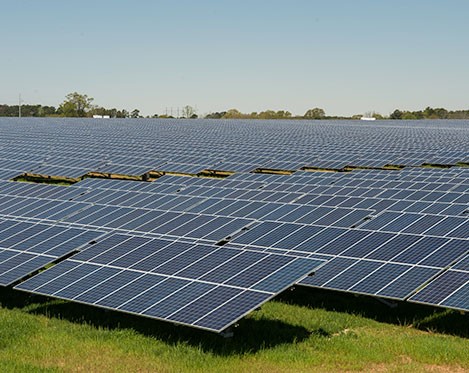How Solar Energy Works
Solar panels are typically mounted on the rooftop but can also be ground mounted. The panels harness energy from the sun and converts it into usable power in your home. If your system produces more power than you can use at any given time, the excess solar is sent to the Georgia Power grid. Whenever your system is not producing enough energy to meet your needs, your building will utilize energy from the Georgia Power grid. Whenever the sun is not shining, during overcast days, or power outages, all your energy needs will be met by the grid unless your solar system includes a battery back-up.
Rooftop Solar Programs
Georgia Power has several programs for customers planning to install a rooftop or ground mount solar system designed to offset their usage. The RNR Instantaneous Netting program allows customers to be compensated for excess solar production sent to the Georgia Power grid. Energy Offset allows customers to maximize the amount of energy they offset with no system size limitations. Solar systems that meet the requirements to participate as a Qualifying Facility may sell the excess or 100% of the solar generation to Georgia Power.
RNR Instantaneous Netting
Excess energy generated by a participating customer’s solar panels are credited at the annual Solar Avoided Energy Cost Rate per kilowatt hour (kWh), summed on a monthly basis and then will be used to reduce the customer’s total monthly bill. This program is currently open for participation as further detailed in the RNR-11 Tariff. Customers are required to register their systems and ensure they meet the Interconnection Requirements. Please register and apply for this program using PowerClerk.
Fees
Current Schedule of Fees
Project Size: ≤ 250 kW AC
Program: RNR or Energy Offset Only
Interconnection Fee: $100
Project Size: >250 kW AC *
Program: Energy Offset Only
Witness Test Fee: $3,900 (weekday)—$4,400 (weekend)
*Projects >250 will have an Interconnection and Witness Test fee
How are Interconnection and Witness Test fees paid?
For projects less than or equal to 250kW AC, the interconnection fee is added as a line item on the customer's bill after the interconnection process is completed. Any projects that are greater than 250kW AC will also be charged a witness test fee billed to the customer through a Non-Electric Service Business (NESB). At this time, fees are charged to customers only.
What is the cost for an Impact Study?
Projects greater than 250kW AC will be charged an impact study fee that ranges from $1,930 – $5,700. The impact study cost for customers connected to our Network Underground is $2,400. The impact study will determine if the solar system poses any risks to safety and reliability. The fee is charged to the customer through a Non-Electric Service Business (NESB). At this time, fees are charged to customers only.
Energy Offset
Energy Offset is designed for residential customers who would like to maximize the size of the solar installation, in order to offset their energy usage. Systems are not designed to push energy back onto the grid, and will not be compensated for any excess energy that is generated. Any customer that has solar installed behind their meter who has not elected to participate in one of our other programs, will be automatically enrolled in this program. Customers are required to register their systems and ensure they meet the Interconnection Requirements. Please register and apply for this program using PowerClerk.
Qualifying Facilities
For more information about the Qualifying Facilities program, you can visit our QF webpage to view program details.




